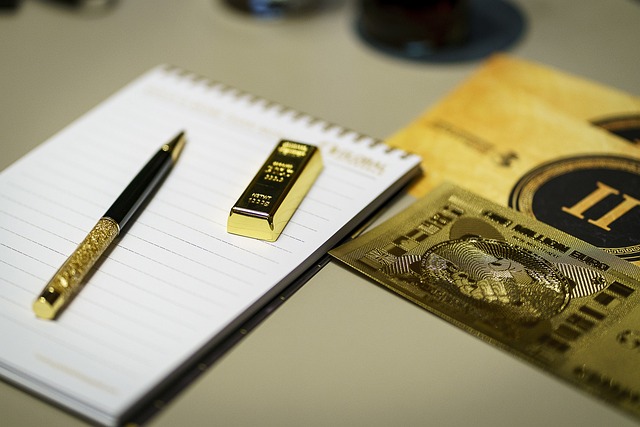To invest in gold through a Roth IRA, establish a self-directed account that allows for physical gold, silver, platinum, and palladium holdings as an alternative to traditional stocks and bonds. Choose a custodian with expertise in precious metals to ensure compliance with IRS regulations. Select IRS-approved, at least .995 fine purity gold investments, such as the American Gold Eagle, Canadian Gold Maple Leaf, or Austrian Philharmonic coins, which are recognized for their purity and legal tender status. Set up a direct rollover to transfer funds from your existing Roth IRA while adhering to IRS rules to maintain tax advantages. A specialized trustee will manage the purchase and storage of your gold in an IRS-approved depository, ensuring regulatory compliance. This strategy can provide a hedge against inflation and currency devaluation, potentially enhancing your retirement portfolio's value through both market growth and the intrinsic worth of gold. Consult with a financial advisor or tax professional experienced in these investments to guide you through the process.
Exploring the transformation of a Roth IRA into a tangible asset portfolio, our article delves into the nuanced process of converting this investment vehicle into gold. This journey begins with establishing a self-directed Roth IRA tailored for precious metals, offering an expansive investment scope beyond the conventional stock and bond markets. As we navigate through setting up your account, adhering to IRS stipulations, selecting a specialized trustee, and choosing the optimal type of gold, we provide a comprehensive guide to secure your financial future with a physical asset as enduring as gold itself. Join us as we explore the intricacies of this investment strategy that bridges the traditional with the tangible.
- Setting Up a Self-Directed Roth IRA for Gold Investments
- Meeting the IRS Requirements for Roth IRA Conversion to Precious Metals
- Selecting a Trustee Specializing in Gold and Precious Metals
- Choosing the Right Type of Gold for Your IRA
- Completing the Rollover: Transferring Funds to Acquire Physical Gold
Setting Up a Self-Directed Roth IRA for Gold Investments

To initiate the process of converting your Roth IRA to gold investments, the first step is to set up a self-directed Roth IRA that accommodates alternative assets such as physical gold, silver, platinum, and palladium. This type of account diverges from traditional IRAs in that it offers investors the autonomy to select specific investments beyond the conventional stocks and bonds. When choosing a custodian for your self-directed Roth IRA, it is imperative to opt for one with experience in handling precious metals. These custodians are familiar with the intricacies of holding these assets within an IRA and can guide you through the compliance and reporting requirements set forth by the Internal Revenue Service (IRS).
Once you have established your self-directed Roth IRA with a qualified custodian, you can proceed to allocate funds to purchase gold. The custodian will facilitate the transaction, ensuring that the gold meets the IRS’s purity standards for retirement accounts. It is crucial to carefully consider the type of gold investment that aligns with your financial goals and risk tolerance—whether it be coins, bars, or allocated or assigned account holdings. This setup enables you to diversify your retirement portfolio in a way that traditional IRAs cannot, potentially providing a hedge against inflation and currency devaluation. By setting up a self-directed Roth IRA specifically for gold investments, you are positioning yourself with the potential to benefit from both financial growth and the intrinsic value of this precious metal.
Meeting the IRS Requirements for Roth IRA Conversion to Precious Metals

To convert a Roth IRA to gold or other precious metals, adherence to Internal Revenue Service (IRS) guidelines is paramount. The IRS stipulates that the gold held within a Roth IRA must be held in an IRS-approved depository and meet specific purity standards set forth by the IRS for it to qualify as a legitimate investment within a Roth IRA framework. These standards dictate that the gold should be at least .995 fine for bullion coins or bars, ensuring that the precious metal investment aligns with the IRS’s purity requirements.
Furthermore, investors must work with a trustee or custodian that specializes in self-directed IRAs and is equipped to handle such alternative assets. This custodian will facilitate the purchase of the gold by ensuring it complies with IRS regulations, maintaining proper records, and reporting the transaction as required. The process involves rolling over funds from an existing Roth IRA into the new self-directed Roth IRA account designated for precious metals investments. It is crucial to execute this rollover correctly to avoid tax implications or penalties. The IRS outlines specific procedures for the rollover, which include direct transfers from the old IRA to the new one to maintain the tax-advantaged status of the Roth IRA. Investors should consult with a tax professional or financial advisor familiar with these rules to ensure compliance throughout the conversion process.
Selecting a Trustee Specializing in Gold and Precious Metals

When considering the conversion of a Roth IRA to gold or other precious metals, it is imperative to select a trustee with expertise in this niche market. A trustee specializing in gold and precious metals brings a wealth of knowledge and experience to the table, ensuring that your investment adheres to IRS guidelines while maximizing the benefits of owning physical gold within your retirement account. These specialized trustees understand the intricacies involved in custodianship of these assets and can guide you through the process of acquiring IRS-approved gold coins or bullion. They also handle the necessary transactions and reporting, taking the complexity out of this unique investment strategy.
To initiate this process, you must open a self-directed Roth IRA account that permits investments in physical precious metals. This type of account differs from traditional IRAs in that it allows for a diversification of assets beyond the conventional stock and bond market. The trustee will collaborate with an IRS-approved depository to store your gold securely, ensuring compliance with all regulations. By partnering with a trustee who is well-versed in the specifics of precious metals investments, you can navigate this alternative investment path confidently, with the assurance that your retirement savings are being managed both effectively and within the legal framework established for Roth IRAs.
Choosing the Right Type of Gold for Your IRA

When considering converting a Roth IRA to gold, selecting the appropriate type of gold is paramount. The Internal Revenue Service (IRS) dictates that for IRA purposes, gold holdings must be held in a form that is considered deliverable and meets certain purity standards. Typically, this includes gold bars or coins that are at least 99.9% pure. Among the most popular options for IRA investment are American Gold Eagles, Canadian Gold Maple Leafs, and Austrian Philharmonic coins. These are not only recognized for their high purity but also for their legal tender status and backing by government mints, which adds a layer of credibility to their value within an IRA.
Furthermore, when investing in physical gold for your Roth IRA, it’s important to consider the storage and custodial requirements. The IRS requires that these precious metals be stored with a trustee company approved by the IRS to hold these types of assets. This custodian will ensure that the gold is securely held and that all transactional rules are adhered to. It’s crucial to choose a reputable and experienced custodian who can facilitate the purchase, transfer, and storage of your chosen gold type within the confines of your Roth IRA framework. This due diligence will help safeguard your investment and ensure compliance with all regulations governing retirement savings invested in precious metals.
Completing the Rollover: Transferring Funds to Acquire Physical Gold

Once you have set up a self-directed Roth IRA that permits investments in physical gold, the next step is to initiate the rollover process. This involves transferring funds from your existing Roth IRA to the new account designated for purchasing gold. The Internal Revenue Service (IRS) outlines specific rules for these types of transfers to ensure they are tax-free and penalty-free. To complete a rollover, you have two main options: a direct rollover or an indirect (60-day) rollover. A direct rollover is the simplest method; your current IRA custodian will send the funds directly to the new custodian holding your self-directed Roth IRA. This way, you never handle the funds, which minimizes the risk of running afoul of the IRS rules.
Should you opt for an indirect rollover, you must personally receive the funds from your old IRA and then deposit them into your new account within 60 days. It’s crucial to adhere strictly to this timeline to avoid taxes and penalties on the distributed amount. Once the funds are in your new self-directed Roth IRA account, you can instruct your custodian to purchase the type of gold allowed within your IRA—commonly, coins or bars that meet specific purity standards set by the IRS. These investments should align with your long-term financial goals and diversification strategy, as physical gold can serve as a hedge against inflation and market volatility.
In conclusion, transitioning a Roth IRA into an investment in gold is a process that, while it requires careful planning and adherence to IRS guidelines, offers a distinct opportunity for diversification within your retirement portfolio. By establishing a self-directed Roth IRA that permits the acquisition of physical gold, you can allocate a portion of your investments to this traditional store of value. This move is bolstered by selecting a trustee with expertise in precious metals and choosing the appropriate form of gold that aligns with your financial objectives. The culmination of these steps—setting up the account, ensuring compliance, picking your investment, and executing the rollover—can be a strategic addition to your retirement savings strategy, offering potential benefits against inflation and market volatility.
